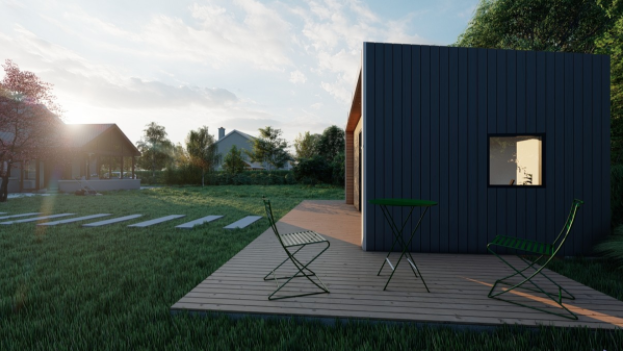

Minimalism, Tiny Homes and the Sustainable Development Goals
by Chris Claffey on the 15/10/2020
The idea of minimalism seems silly at first. Why would anyone want to have less clothes, live in a smaller home or drive a smaller car? Yet having tried it out by downsizing my wardrobe and possessions I have to admit to being rather drawn into the idea.
Minimalism has been floating around newspapers, social media and TV programmes a lot over the past two decades. It could be a reaction to the incessant growth seen in our lives related to the products we consume and the services we avail of. Remember when you could easily slide your phone in your pocket? Nowadays we’re convinced we need to have numerous cosmetics and gadgets with us at all times. I’m almost considering getting one of those stylish European ‘man bags’ to carry around all I need (think I need?). Service wise we must be sure that when we sign up to a broadband, TV or phone company that we are getting the biggest and the best deal with the most ‘gigs’, channels and minutes. Physical size is not the only aspect of this max lifestyle. We are brainwashed into desiring the top-end, most expensive versions of a product rather than deciding what we actually need. Our young people are especially prone to this kind of aggressive marketing and it fuels a lot of arguments in homes around the country.
Minimalism has a rule which has helped me a lot; if you love something, keep it. If coffee is your thing, and you treasure the aroma of freshly ground beans, then by all means invest in a space-taking, eye wateringly expensive machine which will produce a quarter cup of liquid gold. We should prioritise behaviours, people and items in our lives which add value. Much of what’s left can be seen as clutter which serves to distract from the important parts of your life. To give an example, I have a stack of personal photographs upstairs hiding in a box right now from some of the best times in my life. I’m currently in our living room as I type this and there’s a mountain of DVDs taking up an entire shelf beside me. They are pride of place yet as a family we rarely notice them. We don’t even own a DVD player anymore!
I’ve started thinking about situations like this since I first downsized my wardrobe. I had multiple versions of so many items which didn’t fit or suit me anymore. So I carefully chose clothes I knew that I felt good in and gave the rest to others or a charity shop. This left me with clothes I enjoy wearing and made getting dressed simpler. I used to put off going clothes shopping knowing I already had way too many items. Having been educated on the effects of ‘fast fashion’ I didn’t want to be contributing to it but I wasn’t living near a ‘swapshop’ programme or charity shop. By chopping down what I owned to the quality items which remained it mitigated the guilt out of shopping. Knowing I had worn something to its last thread allowed me to be more comfortable when the time came to buy some new clothes. I came to enjoy clothes like I hadn’t before and felt less like I needed to go shopping because I was happier with my appearance.
Right now, I’m exploring how I can apply Minimalism to where I live through the ‘tiny house’ movement. These 400-500 sq feet homes are springing up all over the States, Australia, New Zealand and now Ireland. They are a proven solution for people devastated by the unstable nature of the world economy we live in. After a number of economic crashes, many Americans in the 90’s and 00’s turned to this minimalist living out of necessity. The initial financial costs are affordable and don’t require dreaded mortgage approval and when the house is built energy bills are cheaper for the rest of the time you live there. After transitioning you would imagine many people hated living in something most of us here in Ireland would deem an unbelievably small space. Yet, there’s an awful amount of people you’ll find on this Youtube channel (Living big in a tiny house - https://www.youtube.com/c/livingbig) which testify the benefits for mental health and well being, not just for your pocket.

Photo: Tinyhomes.ie
A 2019 study found that the new habits which tiny house dwellers adopt can cause an average drop in carbon footprint of 45% (The Ecological Footprints of Tiny Home Downsizers: An Exploratory Study - https://www.researchgate.net/publication/332330214_Exploring_the_Ecological_Footprints_of_Tiny_Home_Downsizers). These findings could mean that tiny living may assist individuals and families in playing their part in tackling SDG 12 (sustainable consumption) and 13 (climate action). Changes which had the biggest impact included a tendency to grow more food, buy local produce, collect and use rainwater, use renewable energy sources and overall purchase less goods.
“Advances in sustainable consumption and production spur progress in all the SDGs (Sustainable Development Goals)”
United Nations Sustainable Development Goals report 2020 - https://unstats.un.org/sdgs/report/2020/
In an Irish context, one of the prospects tiny living presents is an opportunity to tackle homelessness; which has formed a dark shadow over Ireland for decades now. Quality, affordable, sustainable housing should be a realistic step for everyone on this small island. For more on this check out: The Tiny House: A Solution for Ireland’s Housing Crisis? - https://greennews.ie/tiny-house-solution-irelands-housing-crisis/
I have my own concerns about transitioning to a tiny house especially if it was out in the ‘sticks’; driving to work, difficult access to waste facilities and the ability to generate enough energy by renewable means are top of the list. Regarding the latter, McMahon Tiny homes, based in Tipperary, create houses with an impressive A2 BER (Building Energy Rating) which means that heating doesn’t require large amounts of electricity. With driving, in a post Covid world where working from home is more and more the norm perhaps living in the suburbs or countryside won’t rev up the kilometers. Nowadays, electric cars have the mileage to navigate long distances and with the initial set up costs of a tiny house being relatively low money saved could be invested into a greener transport option (which are currently heavily subsidised). Waste reduction is one of the greatest changes people experienced in the above study on 80 households due to a rise in local, homegrown food being used so trips to a recycling center may not be as awkward as I fear.
There are a number of Irish companies, linked at the end, creating eco-friendly tiny homes for affordable prices (base models for €30,000) right now. Colla McMahon set up his family-operated business to help provide solutions to the housing problems we face in Ireland. At tinyhomes.ie they use sustainably sourced timber to build a number of different styles of home (pictured above) which offer an affordable option for first time buyers to get on Ireland’s elusive property ladder.
Of course it isn’t feasible for everyone to just change their housing situation in the morning but we can adopt a minimalist lifestyle quite quickly. If you’re interested have a look at some simple suggestions below:
Clothes: If you have half an hour I’d thoroughly recommend minimising your wardrobe. You can do this all at once or section by section. This could lead you to overall shopping less which leads to less transport emissions, waste and peace of mind that you’re not contributing to fast fashion. When you’re done, giving the clothes to a friend can be a good way of reconnecting with them. Alternatively any charity shop will do.
Friends and family: Discuss the idea of gifting experiences rather than physical items. If you have someone in your life who always buys you some clothes or items you don’t need, see if they would prefer meeting up for a hike, night away or a meal in a restaurant. This doesn’t need to be an all or nothing approach, maybe just for your next birthday or Christmas or with a few people. Sustainability is key.
Food: Consume whole foods from local sources as much as possible. Consider getting your shopping delivered. Rather than 10 cars travelling to the supermarket, 1 van does a circuit. Furthermore shops are designed to attract you to buy what you don’t need. I can assure you that sitting at your laptop, watching the price rise, will stop those impulse buys.
Living spaces: Pick a room which you think doesn’t have much personal value attached to it. See if there are things which could be replaced with something which makes you smile but are currently hiding elsewhere. Pride of place in your home should be reserved for photographs of loved ones, souvenirs from a family holiday or postcards from those living abroad. However remember that if what you love is a local football team and you have a huge teddy bear in their colours then by all means plonk that right on the mantelpiece.
For anyone interested in downsizing their home or considering buying a tiny house in Ireland check out the below links:
https://tinyhomes.ie/
http://bigmantinyhomes.ie/
https://www.timberliving.ie/

Photo: Tinyhomes.ie
0 comments
No comments on this blog yet. Would you like to be the first?